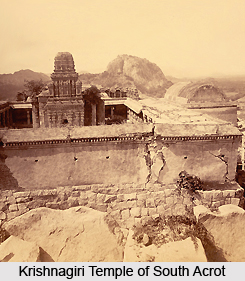 The monuments of Arcot are the handiwork of the Nawabs of the Carnatic who made it their fortified capital. Though few vestiges of its former glory remain, Arcot is of considerable historical interest. It is located at the point where the Palar river valley meets the Coromondal coast, and consequently straddles a highly strategic trade route between Chennai and Bengaluru.
The monuments of Arcot are the handiwork of the Nawabs of the Carnatic who made it their fortified capital. Though few vestiges of its former glory remain, Arcot is of considerable historical interest. It is located at the point where the Palar river valley meets the Coromondal coast, and consequently straddles a highly strategic trade route between Chennai and Bengaluru.
Due to the town`s strategic construction, it has been the site for a number of wars, and this prompted the construction of a formidable fortress therein. It was captured from the Marathas by a Muslim Nawab of Karnataka. Daud Khan, was made governor by Zulfiqar Khan, Aurangzeb`s general, after the fall of Gingee in 1698. In 1710 Saadat-ullah Khan assumed the title Nawab of the Carnatic and made Arcot his capital. The continued feuds between the different dynasties fighting for control of Arcot eventually led to the coming in of the British and French onto the scene, each supporting factions. This was merely an extension of the battle between the British and the French for the control of South India. The capture and subsequent defence of Arcot by a handful of British troops and sepoys against enormous forces is one of the most remarkable feats of British arms in India. The siege lasted fifty days, until 15 November 1751, when reinforcements arrived from Chennai. Subsequently, in 1758, Arcot was surrendered to the French under Lally, but it was recaptured by Colonel Coote in 1760. Mohammed Ali Khan Walajah took over as Nawab, effectively serving as a vassal of the British. His successors soon ran up enormous debts at the hands of English speculators. In 1801, the town was annexed by the British East India Company. It subsequently fell in importance and was incorporated into the district of Vellore of which it is a part today.
The most significant historical monument of Arcot is the Fort as it is part of the famous battle of Arcot which led to British victory in the Carnatic. The fort was captured by the British and the gate renamed as Delhi gate as it signified the beginning of the capture of Delhi. The entrance was constructed with a Mughal arch. It is believed that Clive used to take decisions in the upper room. The old red-brick town walls were obliterated by Tipu Sultan in 1783, but the foundations can still be traced. On the river front the Delhi Gate survives and conveys some idea of the original fort. Over the gateway is Clive`s Room. The road into the town passes the old Taluk Cutcherry and crosses the dry moat. Close to two small tanks is the Tomb of Saadat-ullah Khan and, within the same compound, the Jami Masjid. Today, there are some remains of the tombs of the nawabs and a Jama Masjid which stand as silent witnesses to that period. The Tipu Mahal in Arcot is also worth visiting.
A stone slab with the following inscription can be found near the big doorway, "The gate formed part of the fortification of Arcot during its memorable defence by Lord Clive in 1751."
Beyond the Jami Masjid, are the ruins of the Palace of the Nawabs of the Carnatic, situated on raised ground over the Nawab`s Tank. The shell of the Durbar Room may still be seen. Opposite is the Black Mosque or Kala Masjid. Various tombs lie nearby, including one which is reputed to have sheltered the body of Subadar Nasir Jang, murdered at Gingee in 1750. Another in whitewashed brick is that of Tipu Auliya, a local saint, after whom Tipu Sultan took his name.



















